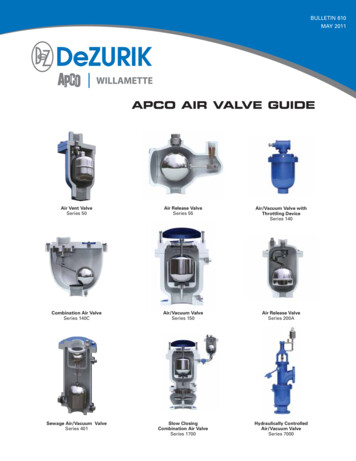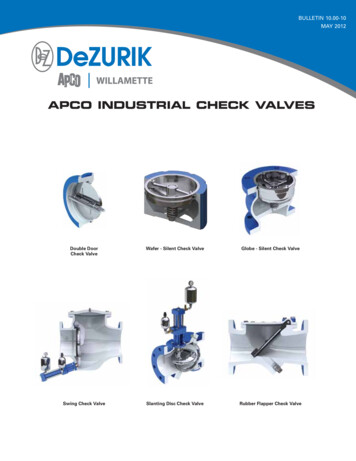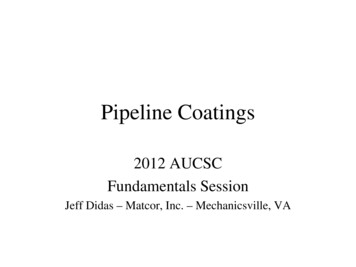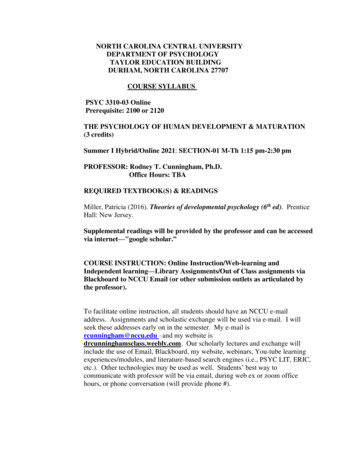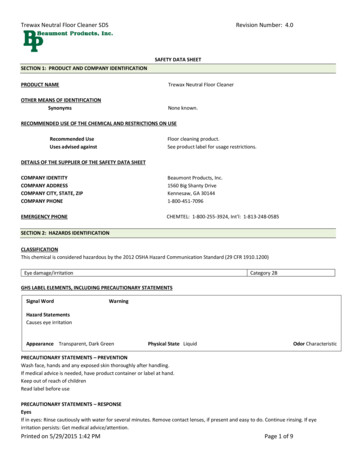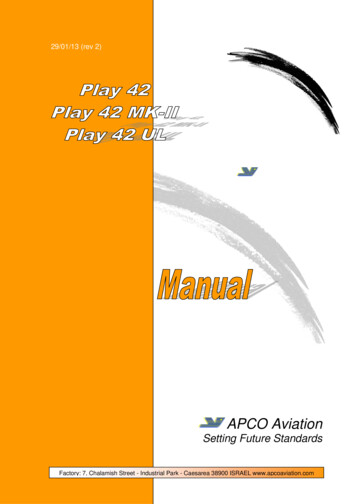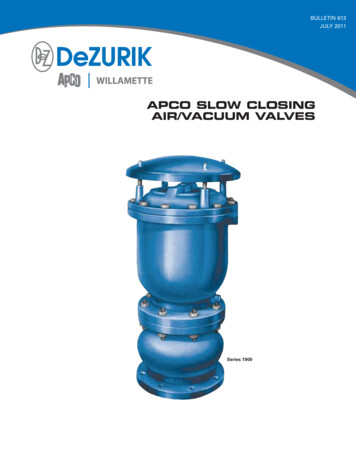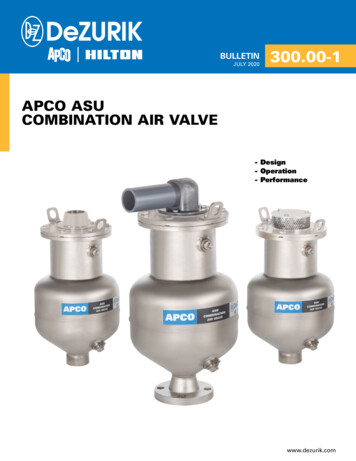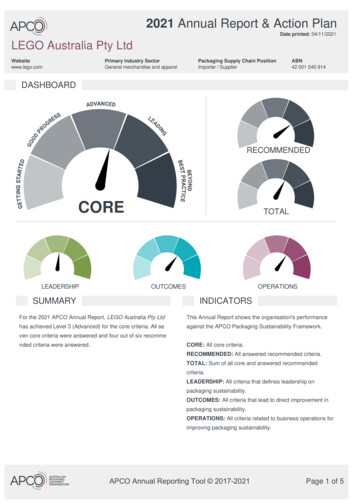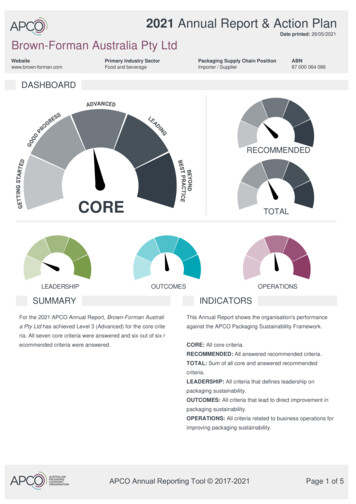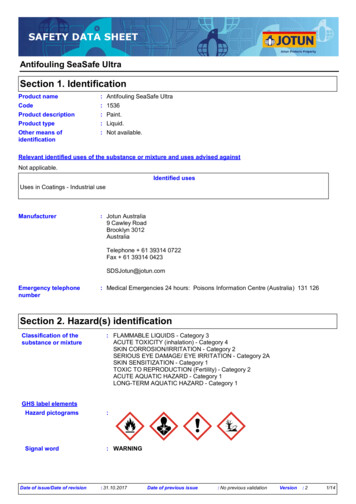
Transcription
SAFETY DATA SHEETAntifouling SeaSafe UltraSection 1. IdentificationProduct name: Antifouling SeaSafe UltraCode: 1536Product description: Paint.Product type: Liquid.Other means ofidentification: Not available.Relevant identified uses of the substance or mixture and uses advised againstNot applicable.Identified usesUses in Coatings - Industrial useManufacturer: Jotun Australia9 Cawley RoadBrooklyn 3012AustraliaTelephone 61 39314 0722Fax 61 39314 0423SDSJotun@jotun.comEmergency telephonenumber1536: Medical Emergencies 24 hours: Poisons Information Centre (Australia) 131 12615362 (ValidationDate)1ApprovedAntifouling.Section 2. Hazard(s) identificationClassification of thesubstance or mixture: FLAMMABLE LIQUIDS - Category 3ACUTE TOXICITY (inhalation) - Category 4SKIN CORROSION/IRRITATION - Category 2SERIOUS EYE DAMAGE/ EYE IRRITATION - Category 2ASKIN SENSITIZATION - Category 1TOXIC TO REPRODUCTION (Fertility) - Category 2ACUTE AQUATIC HAZARD - Category 1LONG-TERM AQUATIC HAZARD - Category 1GHS label elementsHazard pictograms:Signal word: WARNINGDate of issue/Date of revision: 31.10.2017Date of previous issue: No previous validationVersion:21/14
Antifouling SeaSafe UltraSection 2. Hazard(s) identificationHazard statements: Flammable liquid and vapour.Harmful if inhaled.Causes serious eye irritation.Causes skin irritation.May cause an allergic skin reaction.Suspected of damaging fertility.Very toxic to aquatic life with long lasting effects.Precautionary statementsPrevention: Obtain special instructions before use. Do not handle until all safety precautionshave been read and understood. Use personal protective equipment as required.Wear protective gloves. Wear eye or face protection. Keep away from heat, hotsurfaces, sparks, open flames and other ignition sources. No smoking. Keepcontainer tightly closed. Avoid breathing vapour. Use only outdoors or in a wellventilated area. Avoid release to the environment. Wash hands thoroughly afterhandling.: Collect spillage. IF exposed or concerned: Get medical attention. IF INHALED:Remove victim to fresh air and keep at rest in a position comfortable for breathing.Call a POISON CENTER or physician if you feel unwell. IF ON SKIN: Wash withplenty of soap and water. Take off contaminated clothing. Wash contaminatedclothing before reuse. If skin irritation or rash occurs: Get medical attention. IF INEYES: Rinse cautiously with water for several minutes. Remove contact lenses, ifpresent and easy to do. Continue rinsing. If eye irritation persists: Get medicalattention.: Store locked up. Store in a well-ventilated place. Keep cool.ResponseStorageDisposal: Dispose of contents and container in accordance with all local, regional, nationaland international regulations.: Not applicable.Supplemental labelelementsOther hazards which donot result in classification: None known.Additional information: APVMA Approval No 65433. Active constituents: 183 g/L COPPER (Cu) present asCUPROUS THIOCYANATE, 13.8 g/L 4,5-DICHLORO-2-N-OCTYL-3(2H)ISOTHIAZOLONE Solvents: 200-205 g/L HYDROCARBONS LIQUID AROMATIC,178 g/L XYLENE.: IMO Antifouling System Convention compliant (AFS/CONF/26).In complianceSection 3. Composition and ingredient informationSubstance/mixture: MixtureOther means ofidentification: Not available.CAS number/other identifiersCAS number: Not applicable.EC number: Mixture.Product code: 1536Ingredient name% (w/w)CAS numbercopper thiocyanatecolophonySolvent naphtha (petroleum), light arom.xyleneethylbenzenetriaryl one (DCOIT) 10 - 30 10 - 30 10 - 18 10 - 30 5 5 359-81-5Date of issue/Date of revision: 31.10.2017Date of previous issue: No previous validationVersion:22/14
Antifouling SeaSafe UltraSection 3. Composition and ingredient informationThere are no additional ingredients present which, within the current knowledge of the supplier and in theconcentrations applicable, are classified as hazardous to health or the environment and hence requirereporting in this section.Occupational exposure limits, if available, are listed in Section 8.Section 4. First aid measuresDescription of necessary first aid measuresEye contactInhalationSkin contactIngestion: Immediately flush eyes with plenty of water, occasionally lifting the upper and lowereyelids. Check for and remove any contact lenses. Continue to rinse for at least 10minutes. Get medical attention.: Remove victim to fresh air and keep at rest in a position comfortable for breathing.If it is suspected that fumes are still present, the rescuer should wear an appropriatemask or self-contained breathing apparatus. If not breathing, if breathing is irregularor if respiratory arrest occurs, provide artificial respiration or oxygen by trainedpersonnel. It may be dangerous to the person providing aid to give mouth-to-mouthresuscitation. Get medical attention. If necessary, call a poison center or physician.If unconscious, place in recovery position and get medical attention immediately.Maintain an open airway. Loosen tight clothing such as a collar, tie, belt orwaistband. In case of inhalation of decomposition products in a fire, symptoms maybe delayed. The exposed person may need to be kept under medical surveillancefor 48 hours.: Wash with plenty of soap and water. Remove contaminated clothing and shoes.Wash contaminated clothing thoroughly with water before removing it, or weargloves. Continue to rinse for at least 10 minutes. Get medical attention. In theevent of any complaints or symptoms, avoid further exposure. Wash clothingbefore reuse. Clean shoes thoroughly before reuse.: Wash out mouth with water. Remove dentures if any. Remove victim to fresh airand keep at rest in a position comfortable for breathing. If material has beenswallowed and the exposed person is conscious, give small quantities of water todrink. Stop if the exposed person feels sick as vomiting may be dangerous. Do notinduce vomiting unless directed to do so by medical personnel. If vomiting occurs,the head should be kept low so that vomit does not enter the lungs. Get medicalattention. Never give anything by mouth to an unconscious person. If unconscious,place in recovery position and get medical attention immediately. Maintain an openairway. Loosen tight clothing such as a collar, tie, belt or waistband.Most important symptoms/effects, acute and delayedPotential acute health effectsEye contact: Causes serious eye irritation.Inhalation: Harmful if inhaled.Skin contact: Causes skin irritation. May cause an allergic skin reaction.Ingestion: No known significant effects or critical hazards.Over-exposure signs/symptomsEye contactInhalationDate of issue/Date of revision: Adverse symptoms may include the following:pain or irritationwateringredness: Adverse symptoms may include the following:reduced foetal weightincrease in foetal deathsskeletal malformations: 31.10.2017Date of previous issue: No previous validationVersion:23/14
Antifouling SeaSafe UltraSection 4. First aid measuresSkin contactIngestion: Adverse symptoms may include the following:irritationrednessreduced foetal weightincrease in foetal deathsskeletal malformations: Adverse symptoms may include the following:reduced foetal weightincrease in foetal deathsskeletal malformationsIndication of immediate medical attention and special treatment needed, if necessaryNotes to physicianSpecific treatmentsProtection of first-aiders: In case of inhalation of decomposition products in a fire, symptoms may be delayed.The exposed person may need to be kept under medical surveillance for 48 hours.: No specific treatment.: No action shall be taken involving any personal risk or without suitable training. If itis suspected that fumes are still present, the rescuer should wear an appropriatemask or self-contained breathing apparatus. It may be dangerous to the personproviding aid to give mouth-to-mouth resuscitation. Wash contaminated clothingthoroughly with water before removing it, or wear gloves.See toxicological information (Section 11)Section 5. Firefighting measuresExtinguishing mediaSuitable extinguishingmediaUnsuitable extinguishingmediaSpecific hazards arisingfrom the chemicalHazardous thermaldecomposition productsSpecial protective actionsfor fire-fightersSpecial protectiveequipment for fire-fightersHazchem codeDate of issue/Date of revision: Use dry chemical, CO₂, water spray (fog) or foam.: Do not use water jet.: Flammable liquid and vapour. In a fire or if heated, a pressure increase will occurand the container may burst, with the risk of a subsequent explosion. Runoff tosewer may create fire or explosion hazard. This material is very toxic to aquatic lifewith long lasting effects. Fire water contaminated with this material must becontained and prevented from being discharged to any waterway, sewer or drain.: Decomposition products may include the following materials:carbon dioxidecarbon monoxidenitrogen oxidessulfur oxideshalogenated compoundsmetal oxide/oxides: Promptly isolate the scene by removing all persons from the vicinity of the incident ifthere is a fire. No action shall be taken involving any personal risk or withoutsuitable training. Move containers from fire area if this can be done without risk.Use water spray to keep fire-exposed containers cool.: Fire-fighters should wear appropriate protective equipment and self-containedbreathing apparatus (SCBA) with a full face-piece operated in positive pressuremode.: 3Y: 31.10.2017Date of previous issue: No previous validationVersion:24/14
Antifouling SeaSafe UltraSection 6. Accidental release measuresPersonal precautions, protective equipment and emergency proceduresFor non-emergencypersonnel: No action shall be taken involving any personal risk or without suitable training.Evacuate surrounding areas. Keep unnecessary and unprotected personnel fromentering. Do not touch or walk through spilt material. Shut off all ignition sources.No flares, smoking or flames in hazard area. Avoid breathing vapour or mist.Provide adequate ventilation. Wear appropriate respirator when ventilation isinadequate. Put on appropriate personal protective equipment.For emergency responders : If specialised clothing is required to deal with the spillage, take note of anyinformation in Section 8 on suitable and unsuitable materials. See also theinformation in "For non-emergency personnel".Environmental precautions: Avoid dispersal of spilt material and runoff and contact with soil, waterways, drainsand sewers. Inform the relevant authorities if the product has caused environmentalpollution (sewers, waterways, soil or air). Water polluting material. May be harmfulto the environment if released in large quantities. Collect spillage.Methods and material for containment and cleaning upSmall spill: Stop leak if without risk. Move containers from spill area. Use spark-proof tools andexplosion-proof equipment. Dilute with water and mop up if water-soluble.Alternatively, or if water-insoluble, absorb with an inert dry material and place in anappropriate waste disposal container. Dispose of via a licensed waste disposalcontractor.: Stop leak if without risk. Move containers from spill area. Use spark-proof tools andexplosion-proof equipment. Approach the release from upwind. Prevent entry intosewers, water courses, basements or confined areas. Wash spillages into aneffluent treatment plant or proceed as follows. Contain and collect spillage with noncombustible, absorbent material e.g. sand, earth, vermiculite or diatomaceous earthand place in container for disposal according to local regulations (see Section 13).Dispose of via a licensed waste disposal contractor. Contaminated absorbentmaterial may pose the same hazard as the spilt product. Note: see Section 1 foremergency contact information and Section 13 for waste disposal.Large spillSection 7. Handling and storageThe information in this section contains generic advice and guidance. The list of Identified Uses in Section 1 should beconsulted for any available use-specific information provided in the Exposure Scenario(s).Precautions for safe handlingProtective measures: Put on appropriate personal protective equipment (see Section 8). Persons with ahistory of skin sensitization problems should not be employed in any process inwhich this product is used. Avoid exposure - obtain special instructions before use.Avoid exposure during pregnancy. Do not handle until all safety precautions havebeen read and understood. Do not get in eyes or on skin or clothing. Do not ingest.Avoid breathing vapour or mist. Avoid release to the environment. Use only withadequate ventilation. Wear appropriate respirator when ventilation is inadequate.Do not enter storage areas and confined spaces unless adequately ventilated. Keepin the original container or an approved alternative made from a compatible material,kept tightly closed when not in use. Store and use away from heat, sparks, openflame or any other ignition source. Use explosion-proof electrical (ventilating,lighting and material handling) equipment. Use only non-sparking tools. Takeprecautionary measures against electrostatic discharges. Empty containers retainproduct residue and can be hazardous. Do not reuse container.Advice on generaloccupational hygiene: Eating, drinking and smoking should be prohibited in areas where this material ishandled, stored and processed. Workers should wash hands and face beforeeating, drinking and smoking. Remove contaminated clothing and protectiveequipment before entering eating areas. See also Section 8 for additionalinformation on hygiene measures.Date of issue/Date of revision: 31.10.2017Date of previous issue: No previous validationVersion:25/14
Antifouling SeaSafe UltraSection 7. Handling and storageConditions for safe storage,including anyincompatibilities: Store in accordance with local regulations. Store in a segregated and approvedarea. Store in original container protected from direct sunlight in a dry, cool and wellventilated area, away from incompatible materials (see Section 10) and food anddrink. Store locked up. Eliminate all ignition sources. Separate from oxidizingmaterials. Keep container tightly closed and sealed until ready for use. Containersthat have been opened must be carefully resealed and kept upright to preventleakage. Do not store in unlabelled containers. Use appropriate containment toavoid environmental contamination.See Technical Data Sheet / packaging for further information.Section 8. Exposure controls and personal protectionThe information in this section contains generic advice and guidance. The list of Identified Uses in Section 1 should beconsulted for any available use-specific information provided in the Exposure Scenario(s).Control parametersOccupational exposure limitscolophonySolvent naphtha (petroleum), light othiazolin-3-one (DCOIT)Appropriate engineeringcontrolsEnvironmental exposurecontrolsDate of issue/Date of revisionEH40/2005 WELs (United Kingdom (UK),12/2011). Inhalation sensitiser.STEL: 0.15 mg/m³ 15 minutes. Form: FumeTWA: 0.05 mg/m³ 8 hours. Form: FumeNOHSC (Australia, 11/2004). Notes:Documentation for the substances withthis footnote can be found in the 5thEdition of the ACGIH documentation ofthe threshold limit values and biologicalexposure indices (1). For all othersubstances with 'H' in Column 7 thedocumentation can be found in the 6thEdition of the ACGIH documentation ofthe threshold limit values and biologicalexposure indices (2).TWA: 123 mg/m³ 8 hours. Form: All formsTWA: 25 ppm 8 hours. Form: All formsSafe Work Australia (Australia, 1/2014).STEL: 655 mg/m³ 15 minutes.STEL: 150 ppm 15 minutes.TWA: 350 mg/m³ 8 hours.TWA: 80 ppm 8 hours.Safe Work Australia (Australia, 1/2014).STEL: 543 mg/m³ 15 minutes.STEL: 125 ppm 15 minutes.TWA: 434 mg/m³ 8 hours.TWA: 100 ppm 8 hours.ACGIH TLV (United States, 2003).TWA: 0.06 mg/m³ 8 hours.ACGIH TLV (United States).STEL: 0.1 mg/m³ 15 minutes.: Use only with adequate ventilation. Use process enclosures, local exhaustventilation or other engineering controls to keep worker exposure to airbornecontaminants below any recommended or statutory limits. The engineering controlsalso need to keep gas, vapour or dust concentrations below any lower explosivelimits. Use explosion-proof ventilation equipment.: Emissions from ventilation or work process equipment should be checked to ensurethey comply with the requirements of environmental protection legislation. In somecases, fume scrubbers, filters or engineering modifications to the processequipment will be necessary to reduce emissions to acceptable levels.: 31.10.2017Date of previous issue: No previous validationVersion:26/14
Antifouling SeaSafe UltraSection 8. Exposure controls and personal protectionIndividual protection measuresHygiene measuresEye/face protection: Wash hands, forearms and face thoroughly after handling chemical products, beforeeating, smoking and using the lavatory and at the end of the working period.Appropriate techniques should be used to remove potentially contaminated clothing.Contaminated work clothing should not be allowed out of the workplace. Washcontaminated clothing before reusing. Ensure that eyewash stations and safetyshowers are close to the workstation location.: Safety eyewear complying to EN 166 should be used when a risk assessmentindicates this is necessary to avoid exposure to liquid splashes, mists, gases ordusts. If contact is possible, the following protection should be worn, unless theassessment indicates a higher degree of protection: chemical splash goggles.Skin protectionHand protection: Chemical-resistant, impervious gloves complying with an approved standard shouldbe worn at all times when handling chemical products if a risk assessment indicatesthis is necessary. Considering the parameters specified by the glove manufacturer,check during use that the gloves are still retaining their protective properties. Itshould be noted that the time to breakthrough for any glove material may bedifferent for different glove manufacturers. In the case of mixtures, consisting ofseveral substances, the protection time of the gloves cannot be accuratelyestimated.There is no one glove material or combination of materials that will give unlimitedresistance to any individual or combination of chemicals.The breakthrough time must be greater than the end use time of the product.The instructions and information provided by the glove manufacturer on use,storage, maintenance and replacement must be followed.Gloves should be replaced regularly and if there is any sign of damage to the glovematerial.Always ensure that gloves are free from defects and that they are stored and usedcorrectly.The performance or effectiveness of the glove may be reduced by physical/chemicaldamage and poor maintenance.Barrier creams may help to protect the exposed areas of the skin but should not beapplied once exposure has occurred.Wear suitable gloves tested to EN374.Recommended, gloves(breakthrough time) 8 hours: 4H, Teflon, polyvinyl alcohol(PVA), nitrile rubberMay be used, gloves(breakthrough time) 4 - 8 hours: neoprene, PVC, butyl rubberBody protection: Personal protective equipment for the body should be selected based on the taskbeing performed and the risks involved and should be approved by a specialistbefore handling this product. When there is a risk of ignition from static electricity,wear anti-static protective clothing. For the greatest protection from staticdischarges, clothing should include anti-static overalls, boots and gloves.: Appropriate footwear and any additional skin protection measures should beselected based on the task being performed and the risks involved and should beapproved by a specialist before handling this product.: Based on the hazard and potential for exposure, select a respirator that meets theappropriate standard or certification. Respirators must be used according to arespiratory protection program to ensure proper fitting, training, and other importantaspects of use.Other skin protectionRespiratory protectionDate of issue/Date of revision: 31.10.2017Date of previous issue: No previous validationVersion:27/14
Antifouling SeaSafe UltraSection 9. Physical and chemical propertiesAppearancePhysical state: Liquid.Colour: Various colours.Odour: Characteristic.Odour threshold: Not applicable.pH: Not applicable.Melting point: Not applicable.Boiling point: Lowest known value: 136.1 C (277 F) (ethylbenzene). Weighted average: 136.14 C(277.1 F): Closed cup: 25 C (77 F)Flash pointEvaporation rateFlammability (solid, gas): Highest known value: 0.84 (ethylbenzene) Weighted average: 0.79compared withbutyl acetate: Not available.Lower and upper explosive(flammable) limits: 0.8 - 7.6%Vapour pressureRelative density: Highest known value: 1.2 kPa (9.3 mm Hg) (at 20 C) (ethylbenzene). Weightedaverage: 0.98 kPa (7.35 mm Hg) (at 20 C): Highest known value: 3.7 (Air 1) (xylene). Weighted average: 3.7 (Air 1): 1.33 to 1.4 g/cm³Solubility: Insoluble in the following materials: cold water and hot water.Partition coefficient: noctanol/water: Not available.Auto-ignition temperatureDecomposition temperature: Lowest known value: 280 to 470 C (536 to 878 F) (Solvent naphtha (petroleum),light arom.).: Not available.Viscosity: Kinematic (40 C (104 F)): 0.205 cm2/s ( 20.5 mm2/s)Vapour densitySection 10. Stability and reactivityReactivity: No specific test data related to reactivity available for this product or its ingredients.Chemical stability: The product is stable.Possibility of hazardousreactions: Under normal conditions of storage and use, hazardous reactions will not occur.Conditions to avoid: Avoid all possible sources of ignition (spark or flame). Do not pressurise, cut, weld,braze, solder, drill, grind or expose containers to heat or sources of ignition.: Keep away from the following materials to prevent strong exothermic reactions:oxidising agents, strong alkalis, strong acids.: Under normal conditions of storage and use, hazardous decomposition productsshould not be produced.Incompatible materialsHazardous decompositionproductsSection 11. Toxicological informationThere are no data available on the mixture itself. The mixture has been assessed following the conventional method of theCLP Regulation (EC) No 1272/2008 and is classified for toxicological properties accordingly. See Sections 2 and 3 fordetails.Exposure to component solvent vapour concentrations in excess of the stated occupational exposure limit may result inadverse health effects such as mucous membrane and respiratory system irritation and adverse effects on the kidneys, liverand central nervous system. Symptoms and signs include headache, dizziness, fatigue, muscular weakness, drowsinessand, in extreme cases, loss of consciousness.Solvents may cause some of the above effects by absorption through the skin. Repeated or prolonged contact with themixture may cause removal of natural fat from the skin, resulting in non-allergic contact dermatitis and absorption throughthe skin.Date of issue/Date of revision: 31.10.2017Date of previous issue: No previous validationVersion:28/14
Antifouling SeaSafe UltraSection 11. Toxicological informationIf splashed in the eyes, the liquid may cause irritation and reversible damage.Ingestion may cause nausea, diarrhea and vomiting.This takes into account, where known, delayed and immediate effects and also chronic effects of components from shortterm and long-term exposure by oral, inhalation and dermal routes of exposure and eye contact.Contains colophony, 4,5-dichloro-2-n-octyl-4-isothiazolin-3-one (DCOIT). May produce an allergic reaction.Information on toxicological effectsAcute toxicityProduct/ingredient nameResultSpeciesDoseExposurexyleneLC50 Inhalation VapourLD50 OralTDLo DermalLC50 Inhalation Gas.LD50 DermalLD50 OralRatRatRabbitRabbitRabbitRat20 mg/l4300 mg/kg4300 mg/kg4000 ppm 5000 mg/kg3500 mg/kg4 hours4 hours-ethylbenzeneIrritation/CorrosionNot available.SensitisationNot available.MutagenicityNot available.CarcinogenicityNot available.Reproductive toxicityNot available.TeratogenicityNot available.Specific target organ toxicity (single exposure)NameCategoryRoute ofexposureTarget organsSolvent naphtha (petroleum), light arom.Category 3Not -one (DCOIT)Category 3Not applicable.Respiratory tractirritation andNarcotic effectsRespiratory tractirritationNameCategoryRoute ofexposureTarget organsethylbenzeneCategory 2Not determinedhearing organsSpecific target organ toxicity (repeated exposure)Aspiration hazardNameResultSolvent naphtha (petroleum), light arom.ethylbenzeneASPIRATION HAZARD - Category 1ASPIRATION HAZARD - Category 1Information on likely routesof exposure: Not available.Potential acute health effectsEye contactDate of issue/Date of revision: Causes serious eye irritation.: 31.10.2017Date of previous issue: No previous validationVersion:29/14
Antifouling SeaSafe UltraSection 11. Toxicological informationInhalation: Harmful if inhaled.Skin contact: Causes skin irritation. May cause an allergic skin reaction.Ingestion: No known significant effects or critical hazards.Symptoms related to the physical, chemical and toxicological characteristicsEye contactInhalationSkin contactIngestion: Adverse symptoms may include the following:pain or irritationwateringredness: Adverse symptoms may include the following:reduced foetal weightincrease in foetal deathsskeletal malformations: Adverse symptoms may include the following:irritationrednessreduced foetal weightincrease in foetal deathsskeletal malformations: Adverse symptoms may include the following:reduced foetal weightincrease in foetal deathsskeletal malformationsDelayed and immediate effects as well as chronic effects from short and long-term exposureShort term exposurePotential immediateeffects: Not available.Potential delayed effects: Not available.Long term exposurePotential immediateeffects: Not available.Potential delayed effects: Not available.Potential chronic health effectsNot available.GeneralCarcinogenicity: Once sensitized, a severe allergic reaction may occur when subsequently exposedto very low levels.: No known significant effects or critical hazards.Mutagenicity: No known significant effects or critical hazards.Teratogenicity: No known significant effects or critical hazards.Developmental effects: No known significant effects or critical hazards.Fertility effects: Suspected of damaging fertility.Numerical measures of toxicityAcute toxicity estimatesRouteATE valueOralDermalInhalation (vapours)Inhalation (dusts and mists)49860.6 mg/kg8427.2 mg/kg68.46 mg/l4.986 mg/lDate of issue/Date of revision: 31.10.2017Date of previous issue: No previous validationVersion:210/14
Antifouling SeaSafe UltraSection 11. Toxicological informationSection 12. Ecological informationToxicityProduct/ingredient nameResultSpeciesExposureFish - Lepomis macrochirusDaphnia96 hours48 hoursAlgaeFishAlgaeDaphniaFishCrustaceans - Daphnia magna72 hours96 hours48 hours48 hours96 hours48 hoursFish - Lepomis macrochirusFish - Onchorhynchus mykissFish96 hours96 hours97 dayscopper thiocyanateAcute LC50 0.07 mg/lSolvent naphtha (petroleum), Acute EC50 10 mg/llight arom.Acute IC50 10 mg/lAcute LC50 10 mg/lethylbenzeneAcute EC50 7.2 mg/lAcute EC50 2.93 mg/lAcute LC50 4.2 mg/l4,5-dichloro-2-n-octylAcute EC50 0.0057 mg/l4-isothiazolin-3-one (DCOIT)Acute LC50 0.014 mg/lAcute LC50 0.0027 mg/lChronic NOEC 0.00056 mg/lPersistence and degradabilityProduct/ingredient nameAquatic half-lifePhotolysisBiodegradabilitycopper thiocyanateSolvent naphtha (petroleum),light thiazolin-3-one (DCOIT)--Not readilyNot readily--ReadilyReadilyReadilyBioaccumulative potentialProduct/ingredient nameLogPowBCFPotentialcolophonySolvent naphtha (petroleum),light arom.xyleneethylbenzene1.9 to 7.7-10 to 2500highhigh3.123.68.1 to 25.9-lowlowMobility in soilSoil/water partitioncoefficient (KOC)Other adverse effects: Not available.: No known significant effects or critical hazards.Section 13. Disposal considerationsDisposal methodsDate of issue/Date of revision: The generation of waste should be avoided or minimised wherever possible.Disposal of this product, solutions and any by-products should at all times complywith the requirements of environmental protection and waste disposal legislationand any regional local authority requirements. Dispose of surplus and nonrecyclable products via a licensed waste disposal contractor. Waste should not bedisposed of untreated to the sewer unless fully compliant with the requirements ofall authorities with jurisdiction. Waste packaging should be recycled. Incineration orlandfill should only be considered when recycling is not feasible. This material andits container must be disposed of in a safe way. Care should be taken whenhandling emptied containers that have not been cleaned or rinsed out. Empty: 31.10.2017Date of previous issue: No previous validationVersion:211/14
Antifouling SeaSafe UltraSection 13. Disposal considerationscontainers or liners may retain some product residues. Vapour from productresidues may create a highly flammable or explosive atmosphere inside thecontainer. Do not cut, weld or grind used containers unless they have been cleanedthoroughly internally. Avoid dispersal of spilt material and runoff and contact withsoil, waterways, drains and sewers.Do not allow to enter drains or watercourses. Material and/or container must be disposed of as hazardous waste.Section 14. Transport informationADGADR/RIDIMDGIATAUN number1263126312631263UN propershipping namePaintPaintPaintPaintTransport hazardclass(es)3333Packing .AdditionalinformationHazchem code 3YThe environmentallyhazardous substancemark is not requiredwhen transported insize
Antifouling SeaSafe Ultra SAFETY DATA SHEET Product name :Antifouling SeaSafe Ultra Code :1536 Emergency telephone number: Manufacturer :Jotun Australia 9 Cawley Road Brooklyn 3012 Australia Telephone 61 39314 0722 Fax 61 39314 0423 SDSJotun@jotun.com Antifouling. 15362 (ValidationDate)1 Approved Product description:Paint.
